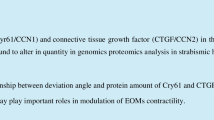Abstract
Background
We compared the oxidative stress and antioxidant capacities of the medial rectus muscles (MRMs) between the patients with constant exotropia and control subjects.
Methods
A total of 40 MRMs from patients with constant exotropia and 40 MRMs from normal donor eyes (controls) were assessed. Neuronal nitric oxide synthase (nNOS), superoxide dismutase (SOD), and catalase levels were compared between the two groups using western blot analysis. In addition, the lipofuscin accumulation level was compared between the exotropic and control groups.
Results
According to western blot analysis, the nNOS level was significantly higher in the exotropic group than in the control group (P < 0.05). On the other hand, a catalase expression level was higher in the control group than in the exotropic group (P < 0.05). The SOD1 level did not show a significant difference between the two groups. The relative lipofuscin fluorescence intensity was higher in the exotropic group than in the control group (P < 0.001).
Conclusions
Based on these findings, the MRMs of patients with exotropia had a redox imbalance status. Further study is needed to investigate whether this imbalance in antioxidant capacity is present in the extraocular muscles of patients with other strabismus.



Similar content being viewed by others
References
Lawler JM, Cline CC, Hu Z, Coast JR (1997) Effect of oxidative stress and acidosis on diaphragm contractile function. Am J Physiol 273:R630–636
Reid MB (1998) Role of nitric oxide in skeletal muscle: synthesis, distribution and functional importance. Acta Physiol Scand 162:401–409
Reid MB, Shoji T, Moody MR, Entman ML (1992) Reactive oxygen in skeletal muscle. II Extracellular release of free radicals. J Appl Physiol 73:1805–1809
Moylan JS, Reid MB (2007) Oxidative stress, chronic disease, and muscle wasting. Muscle Nerve 35:411–429. doi:10.1002/mus.20743
Lawler JM, Kim JH, Kwak HB, Barnes WS (2010) Redox modulation of diaphragm contractility: Interaction between DHPR and RyR channels. Free Radic Biol Med 49:1969–1977. doi:10.1016/j.freeradbiomed.2010.09.025
Fischer MD, Gorospe JR, Felder E, Bogdanovich S, Pedrosa-Domellof F, Ahima RS, Rubinstein NA, Hoffman EP, Khurana TS (2002) Expression profiling reveals metabolic and structural components of extraocular muscles. Physiol Genomics 9:71–84. doi:10.1152/physiolgenomics.00115.2001
Powers SK, Kavazis AN, DeRuisseau KC (2005) Mechanisms of disuse muscle atrophy: role of oxidative stress. Am J Physiol Regul Integr Comp Physiol 288:R337–344. doi:10.1152/ajpregu.00469.2004
Sohal RS, Weindruch R (1996) Oxidative stress, caloric restriction, and aging. Science 273:59–63
Couillard A, Prefaut C (2005) From muscle disuse to myopathy in COPD: potential contribution of oxidative stress. Eur Respir J 26:703–719. doi:10.1183/09031936.05.00139904
Aoi W, Sakuma K (2011) Oxidative stress and skeletal muscle dysfunction with aging. Curr Aging Sci 4:101–109
Niess AM, Simon P (2007) Response and adaptation of skeletal muscle to exercise–the role of reactive oxygen species. Front Biosci 12:4826–4838
Ragusa RJ, Chow CK, St Clair DK, Porter JD (1996) Extraocular, limb and diaphragm muscle group-specific antioxidant enzyme activity patterns in control and mdx mice. J Neurol Sci 139:180–186
Sies H (1991) Oxidative stress: Oxidants and antioxidants. Academic Press, London
Jones DP (2006) Redefining oxidative stress. Antioxid Redox Signal 8:1865–1879. doi:10.1089/ars.2006.8.1865
Kobzik L, Reid MB, Bredt DS, Stamler JS (1994) Nitric oxide in skeletal muscle. Nature 372:546–548. doi:10.1038/372546a0
Silvagno F, Xia H, Bredt DS (1996) Neuronal nitric-oxide synthase-mu, an alternatively spliced isoform expressed in differentiated skeletal muscle. J Biol Chem 271:11204–11208
Richmonds CR, Kaminski HJ (2001) Nitric oxide synthase expression and effects of nitric oxide modulation on contractility of rat extraocular muscle. FASEB J 15:1764–1770
de Gritz BG, Rahko T, Korpela H (1994) Diet-induced lipofuscin and ceroid formation in growing pigs. J Comp Pathol 110:11–24
Ahmed MI, Gladden JD, Litovsky SH, Lloyd SG, Gupta H, Inusah S, Denney T Jr, Powell P, McGiffin DC, Dell'Italia LJ (2010) Increased oxidative stress and cardiomyocyte myofibrillar degeneration in patients with chronic isolated mitral regurgitation and ejection fraction >60 %. J Am Coll Cardiol 55:671–679. doi:10.1016/j.jacc.2009.08.074
Terman A, Brunk UT (1998) Ceroid/lipofuscin formation in cultured human fibroblasts: the role of oxidative stress and lysosomal proteolysis. Mech Ageing Dev 104:277–291
Powell SR, Wang P, Divald A, Teichberg S, Haridas V, McCloskey TW, Davies KJ, Katzeff H (2005) Aggregates of oxidized proteins (lipofuscin) induce apoptosis through proteasome inhibition and dysregulation of proapoptotic proteins. Free Radic Biol Med 38:1093–1101. doi:10.1016/j.freeradbiomed.2005.01.003
Terman A, Dalen H, Brunk UT (1999) Ceroid/lipofuscin-loaded human fibroblasts show decreased survival time and diminished autophagocytosis during amino acid starvation. Exp Gerontol 34:943–957
Stamler JS, Meissner G (2001) Physiology of nitric oxide in skeletal muscle. Physiol Rev 81:209–237
Park JH, Straub VA, O'Shea M (1998) Anterograde signaling by nitric oxide: characterization and in vitro reconstitution of an identified nitrergic synapse. J Neurosci 18:5463–5476
Conflict of interest
None of the authors has financial or proprietary interests in any material or method mentioned in this study.
Funding sources
This research received no specific grant from any funding agency in the public, commercial or not-for-profit sectors.
Author information
Authors and Affiliations
Corresponding author
Rights and permissions
About this article
Cite this article
Jung, S.K., Choi, J.S. & Shin, S.Y. Change in the antioxidative capacity of extraocular muscles in patients with exotropia. Graefes Arch Clin Exp Ophthalmol 253, 551–556 (2015). https://doi.org/10.1007/s00417-014-2794-0
Received:
Revised:
Accepted:
Published:
Issue Date:
DOI: https://doi.org/10.1007/s00417-014-2794-0




